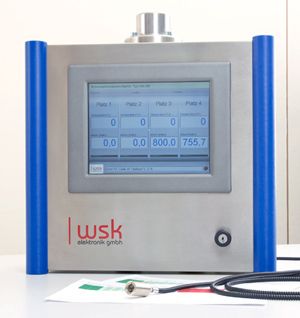Multichannel ratio pyrometer
Referenz WSK Elektronik

Optimized welding/shrinking process by high-speed ratio pyrometer (= infrared thermometer) with glass fiber sensor.
The device was designed to perform shrinking and welding processes in production in a temperature-controlled/regulated manner. This WSK innovation currently has four measuring channels, but is modular and can be equipped with a different number of channels. The nominal measurement temperature of the device is 700 °C to 1,300 °C.
The device detects the peak temperature of the process and sends a stop signal to the welding controller when the set temperature is reached. This response occurs in the microsecond range. It is possible to achieve optimum process quality due to the shrink/weld being controlled at this temperature.
The temperature can additionally be monitored for limit values in order to qualify the manufactured part as NOK, if necessary, if the desired temperature has not been reached. In addition, the electrical welding work/power can also be measured to achieve even better process monitoring.
The measurement via a fiber optic light guide also allows measurement in narrow and problematic locations. For each measuring channel the device has to be equipped with a compact fiber optic sensor (fiber optic cable with optics). Standard length 3 m, other lengths on request. The optics and the fiber optic are very robust and can be used in harsh environments. A positioning laser allows the optics to be optimally aligned with the welding/shrinking position.
The temperature measuring principle based on the multi-color or also quotient pyrometer is an optimized measuring method of the infrared temperature measurement. Here, the temperature is determined at two wavelengths (standard IR thermometers only measure at one wavelength = light color).
This measuring method is largely independent of the material as well as the size and distance of the measuring spot. For the user, this means that the measurement process is simpler and less critical than with standard IR pyrometers. For example, contamination or glass fiber breakage are frequent problems with standard devices.